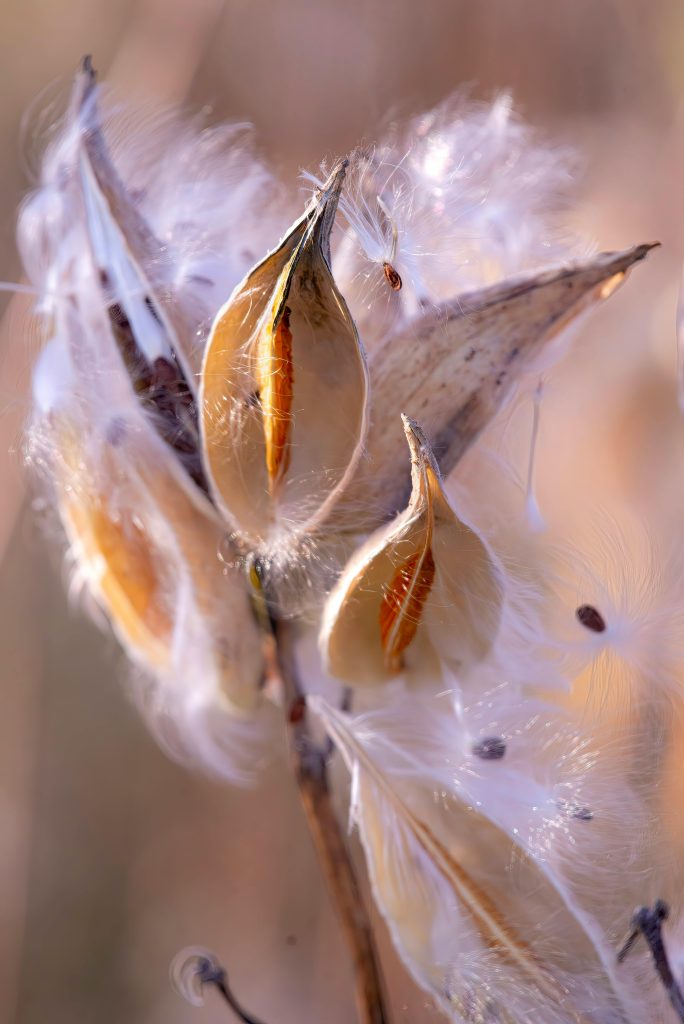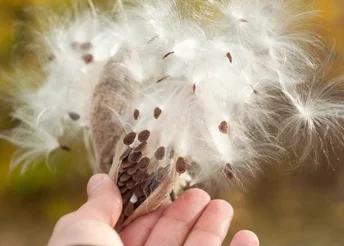Where Math Meets Magic: A Morning with Milkweed

“Look at all the wishes in the sky! They’re flying everywhere! There’s millions of them! Let’s catch them!”
On this warm October morning, Mateo’s excitement leads our outdoor exploration. The silky milkweed seeds drifting through our classroom are more than just a science lesson in wind dispersal—they’re the perfect way to explore early math, especially estimation. To the children, we call them wishes or fluff. These “wishes” give us a hands-on way to learn about how many, how fast, and how big—all without needing a single number.
Before children can count precisely, they need a sense of quantity—knowing what’s a lot and what’s a little. A milkweed pod bursting open gives an overwhelming amount of seeds and fluff, impossible to count, which makes it perfect for practicing estimation.
“How many seeds are inside that pod?” I ask.
Five-year-old Leah wrinkles her nose. “A million! A whole million!” she declares. Four-year-old Trey adds, “Yeah! But maybe one more than a million!”
Their guesses aren’t about getting the right number—they’re about understanding “many.”

I scoop handfuls of fluff into each hand and hold them out. “Which pile has more wishes? Which has less?” The children lean in, wave their hands, and point without hesitation. Some grab a little handful and let it float back to the ground, others try to gather as much as they can in one scoop. They’re not counting—they’re feeling and seeing “more” and “less” through play, letting their senses guide them.
A gust of wind sweeps through, lifting a swirling cloud of fluff. Riley jumps back, laughing, “That’s too many to hold!” Every toss, catch, and breeze sparks words and ideas about size, amount, and difference—building the vocabulary that will later help them understand proportion and comparison, all without leaving the joy of play.
Not every seed adventure is about huge piles. Sometimes, the magic is in noticing just a few. Mateo crouches down and, without pointing or counting, says, “ I found three pods on the ground!” His eyes light up as he grabs the pods in his hand. Riley stoops, and sweeps together a clump of “wishes” and never wanting to be outdone, calls out, “ I found five wishes!”

The children are working on their subitizing—recognizing small groups without counting—but they don’t even know they’re doing math. It’s just part of the game: gathering seeds, tossing them gently, seeing patterns in the fluff. Through play, they begin to connect what “a few” feels like versus what “lots” looks like, building a natural sense of number that will grow into bigger math thinking later.
The wind is the ultimate playmate. Mateo releases a seed and it sails quickly; Maria lets hers drift more slowly. “Yours is faster!” Mateo shouts.
“Mine went farther!” Maria counters, laughing as her seed floats past the slide.

We try again, each child experimenting with a different throw or opening their hand just enough for the wind to catch the fluff. They watch, guess, and shout predictions: “Mine will go to the fence!” or “That one spun back to me!” Each toss is a playful experiment. Children are estimating speed, distance, and direction, learning cause-and-effect without realizing they’re practicing the foundations of physics and algebraic thinking.
Trey holds a small dark seed. “This is the heavy part—it makes it fall,” he says, then lifts the fluff. “And this is the light part!” Years of teaching have taught me to pause here—he’s not just describing what he sees, he’s sharing his understanding of weight.
These floating wishes are more than fun—they’re a living math and science lab. Children aren’t counting or adding; they’re estimating. They’re noticing lots versus a few, faster versus slower, heavier versus lighter. They’re practicing subitizing with small groups of seeds and estimating larger groups. They’re learning to predict, test, and observe—the beginnings of mathematical thinking and scientific inquiry.

By letting children explore speed, size, and quantity through estimation and subitizing, we scatter the seeds of future learning. Some guesses are way off, others surprisingly close. In that gap between guess and reality, real learning happens.
Milkweed seeds aren’t just fluff or future plants. They’re sparks of curiosity, invitations to wonder, and the start of lifelong thinking about math and science. Watching children follow these flying wishes is a reminder that the best lessons often come when we let them guess, explore, and imagine.
Love it even can blend with science
Very interesting
I learn something different everyday.